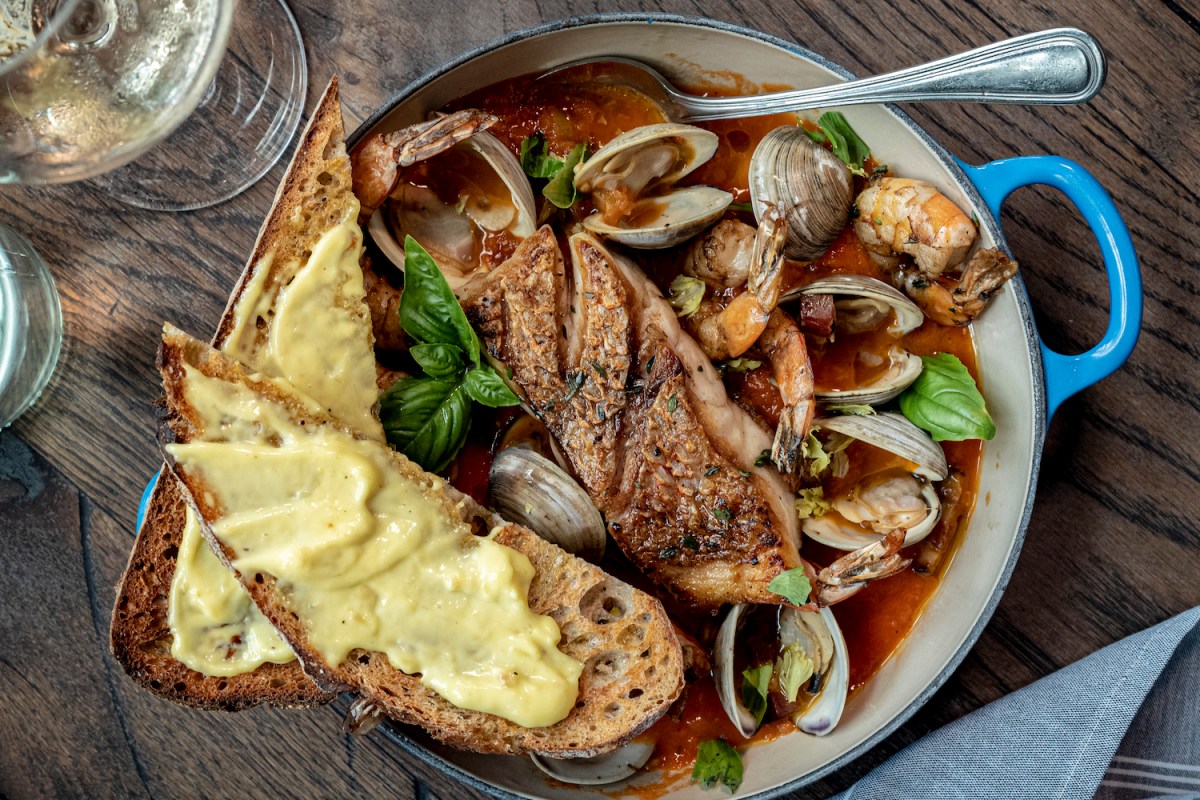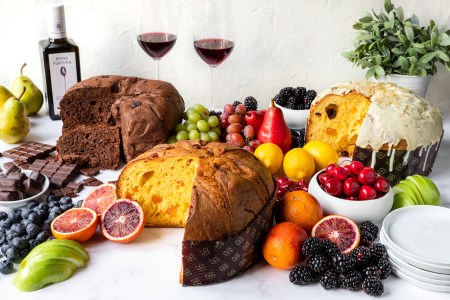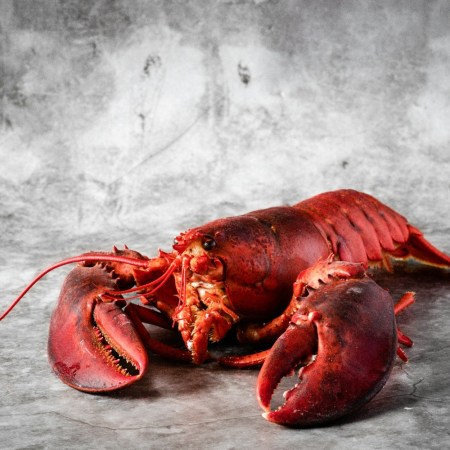Christmas Eve has always been my favorite day of the year. Growing up, while most people I knew had their big holiday celebrations on Christmas Day, my family always pulled out the stops the night before. And like any good Italian American family, we didn’t dine on turkey or ham or casseroles of any kind — rather, we celebrated Feast of the Seven Fishes, and still do every year.
Fasting from meat before a holy holiday is a very Roman Catholic thing to do, and back in the old days, fish was certainly more abundant and more affordable than meat in Italy. Even today, it’s very common in the southern parts of the country, from Rome to Sicily, to eat some sort of fish on Christmas Eve. So when Italians came to the states in the early and mid 1900s, they brought their Christmas Eve traditions with them. And decidedly, they made it their own in the process because Feast of the Seven Fishes is definitely an Italian American thing. Why the number seven? It also ties back to Catholic symbols, like the seven sacraments, seven deadly sins and seven days of creation. Plus, it’s a pretty opulent and festive way to close out the year.
In my youth, there were a true seven fishes to be had on Christmas Eve. My nonna always made pasta with anchovies and tuna, shrimp, eel, scallops, fried calamari and smelts, and baccalà, a dried and salted cod which is probably the most traditional of the fishes. My grandfather made his “famous” seafood salad, a gorgeous, lemony mix of clams, calamari and shrimp that was always served on a clamshell-shaped plate. The menu was the same every single year, and that’s just how everyone liked it.
You can’t stop time, and although my grandparents are gone, my family has taken over the Christmas Eve celebration. My dad is a man of tradition, but he’s certainly not a fan of culinary boredom, which means he’s always thinking of something new and exciting to make. One year he made shrimp étouffée, and last year he made a hearty cioppino that received raves from all around the table. We still have a pasta course, usually prepared simply with anchovies, garlic and olive oil. Dad fries calamari and smelts, and everyone eats them hot out of the oil. And I’ve taken on the tradition of making my grandfather’s seafood salad, which always brings me back to those childhood celebrations. The whole affair is a nice reminder that tradition doesn’t have to be followed to a T for it to be wonderful.
This Panettone Will Put Your Grandma’s Recipe to Shame
You won’t want to regift this cakeWhile you certainly don’t have to prepare seven fishes to celebrate Christmas Eve like an Italian American, I can offer some culinary advice to make for a delicious dinner. A seafood salad is a great way to incorporate multiple fishes into one dish, but you could simply open a can of conservas for an easy appetizer. Smelts aren’t that easy to find, but they are so excellent when breaded, fried and served with a squeeze of lemon if your fishmonger or grocery store happens to have them. But calamari will certainly do if you can’t find the tiny fish. A simple pasta with anchovies is always a winner, but you could also make linguine with white wine and clams (alle vongole) for a main course. As for the baccalà, roast it puttanesca-style with tomatoes, capers and olives, turn it into fritters, or make baccalà mantecato, a classic Venetian recipe that whips the white fish into a creamy, spreadable delight. Just remember that this is salt-cured fish, so plan ahead because you have to soak it for a few days before using.
Or, just like one of my family’s newly-minted traditions, you could serve up a crowd-pleasing cioppino with a hunk of crusty bread, which is actually another Italian American delicacy that was popularized in San Francisco in the late 1800s. Fishermen (many of which were Italian immigrants) used whatever was leftover from the day’s catch to make the tomato-based stew. It started out as something they would eat on their boats and in their homes, but the dish caught on, and restaurants began serving it in the early 1900s. Chef William Dissen — executive chef of The Market Place and Haymaker, as well as a judge of the 2022 James Beard Awards — has a perfect recipe for cioppino, which can be made partly in advance. “During the holidays, it’s all about planning ahead,” Dissen says. “The tomato fennel broth can be made up to five days in advance, or even made now and frozen until needed. Make sure to get all of your seafood as fresh as possible.”
Cioppino
Servings: 6
Ingredients
- 6 Tbsp. olive oil, divided
- 1 cup fennel bulb, diced
- 1 ½ cups yellow onion, diced
- ½ cup celery, diced
- 2 Tbsp. garlic, minced
- ½ tsp. red pepper flakes
- 1 28 oz. can San Marzano tomatoes
- 4 cups fish stock or fumet
- ½ cup Pernod
- 1 cup dry white wine
- Kosher salt, to taste
- Black pepper, to taste
- 1 lb. snapper, cut into large pieces
- 1 lb. large peeled and deveined shrimp
- 2 dozen littleneck clams, steamed
- 4 Tbsp. basil, roughly chopped
- 4 Tbsp. flat leaf parsley, roughly chopped
- 1/2 qt. Dukes Real Mayo
- 2 Tbsp. confit garlic puree
- Juice of ½ lemon
- ½ Tbsp. saffron
- ½ cup white wine
Directions
-
For the Cioppino
-
In a large dutch oven, heat 3 Tbsp. of the olive oil over medium-high heat. Stir in the fennel, onion and celery and cook until translucent and tender, about 5 minutes.
-
Stir in the garlic and red pepper flakes, and cook for about 2 minutes, or until fragrant.
-
Stir in the Pernod and white wine, bring to a simmer and reduce by half. Stir in the tomatoes and fish stock or fumet. Bring to a simmer and allow to cook uncovered for about 25-30 minutes, stirring occasionally.
-
Use an immersion blender to puree to a rustic consistency. Season with salt and pepper to taste.
-
Add the snapper and shrimp and bring to a simmer again. Lower the heat to medium-low, and cover and cook for about 5 minutes or until the seafood is cooked through. Stir in the steamed clams. Adjust the seasoning as needed.
-
Ladle the cioppino into large shallow bowls, and drizzle with the remaining olive oil. Garnish with the chopped basil and parsley, and serve immediately with toasted sourdough smeared with the saffron aioli.
-
-
For the Saffron Aioli
-
Add the saffron and white wine to a small sauce pot and simmer until the wine is deeply colored and reduced to 1 oz. Strain into a mixing bowl. Add the mayo, garlic puree and lemon and stir until combined.
-
Every Thursday, our resident experts see to it that you’re up to date on the latest from the world of drinks. Trend reports, bottle reviews, cocktail recipes and more. Sign up for THE SPILL now.

























